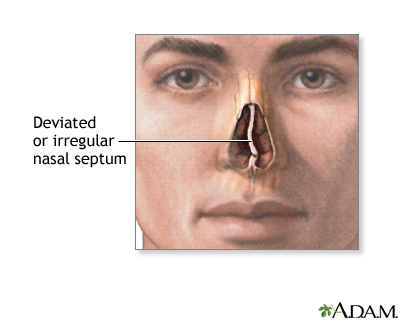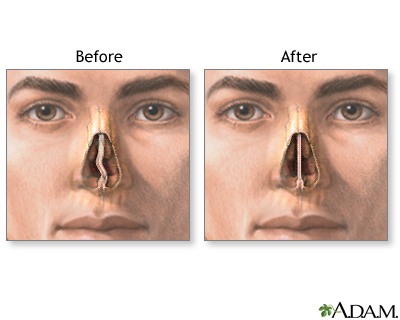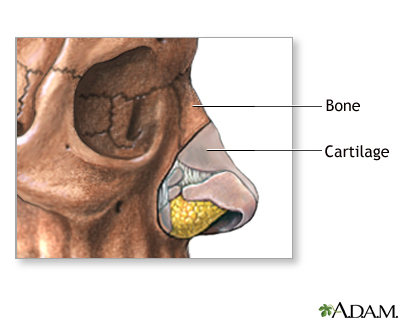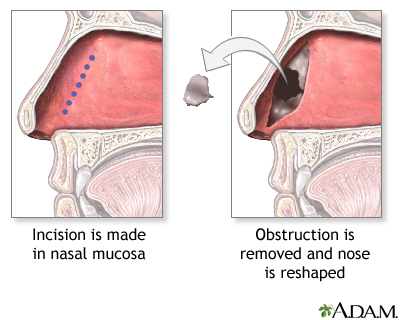Rhinoplasty

Description
Rhinoplasty can be performed under local or general anesthesia, depending on the exact procedure and the person's preference. It is performed in a surgeon's office, a hospital, or an outpatient surgery center. Complex procedures may require a short hospital stay. The procedure often takes 1 to 2 hours. It may take longer.
With local anesthesia, the nose and the area around it are numbed. You will probably be lightly sedated, but awake during the surgery (relaxed and not feeling pain). General anesthesia allows you to sleep through the operation.
The surgery is usually done through a cut (incision) made inside the nostrils. In some cases, the cut is made from outside, around the base of the nose. This type of cut is used to perform work on the tip of the nose or if you need a cartilage graft. If the nose needs to be narrowed, the incision may extend around the nostrils. Small incisions may be made on the inside of the nose to break, and reshape the bone.

A splint (metal or plastic) may be placed on the outside of the nose. This helps maintain the new shape of the bone when the surgery is finished. Soft plastic splints or nasal packs also may be placed in the nostrils. This helps keep the dividing wall between the air passages (septum) stable.

Why the Procedure is Performed
Rhinoplasty is one of the most common plastic surgery procedures. It can be used to:
- Reduce or increase the size of the nose
- Change the shape of the tip or the nasal bridge
- Narrow the opening of the nostrils
- Change the angle between the nose and the upper lip
- Correct a birth defect or injury
- Help relieve some breathing problems
Nose surgery is considered elective when it is done for cosmetic reasons. In these cases, the purpose is to change the shape of the nose to one that the person finds more desirable. Many surgeons prefer to perform cosmetic nose surgery after the nasal bone has finished growing. This is around age 14 or 15 for girls and a bit later for boys.
Risks
Risks for anesthesia and surgery in general are:
- Reactions to medicines, problems breathing
- Bleeding, infection, or bruising
Risks for this procedure include:
- Loss of support of the nose
- Contour deformities of the nose
- Worsening of breathing through the nose
- Need for further surgery
After surgery, tiny blood vessels that have burst may appear as tiny red spots on the skin surface. These are usually minor, but are permanent. There are no visible scars if the rhinoplasty is performed from inside the nose. If the procedure narrows flared nostrils, there may be small scars at the base of the nose that are not often visible.
In rare cases, a second procedure is needed to fix a minor deformity.
Before the Procedure
Your surgeon may give you instructions to follow before your surgery. You may need to:
- Stop any blood thinning medicines. Your surgeon will give you a list of these medicines.
- See your regular health care provider to have some routine tests and make sure it is safe for you to have surgery.
- To aid with healing, stop smoking 2 to 3 weeks before and after surgery.
- Arrange to have someone drive you home after surgery.

After the Procedure
You will usually go home on the same day as your surgery.
Right after surgery, your nose and face will be swollen and painful. Headaches are common.
The nasal packing is usually removed in 3 to 5 days, after which you will feel more comfortable.
The splint may be left in place for 1 to 2 weeks.
References
https://medlineplus.gov/ency/article/002983.htm
ISO 9001 Certification for Quality Management System &
Certification of Iran National Hospital Accreditation with Excellent Grade
Teaching Patients about
Appendicitis
Prepared by: Quality Improvement, Education and Research Office
Voice Costumer Service (For Complaints, compliments and comments)
SMS: 30001845
Pursuance: Hospital Management
Add: Iran, Mashhad, Shahid Mofatteh Street, Vahid Street, Vahid 3 Alley.
Phone: 32877001




